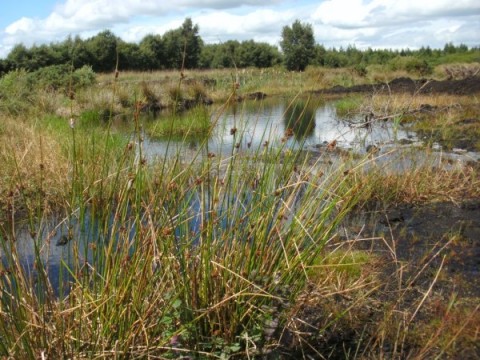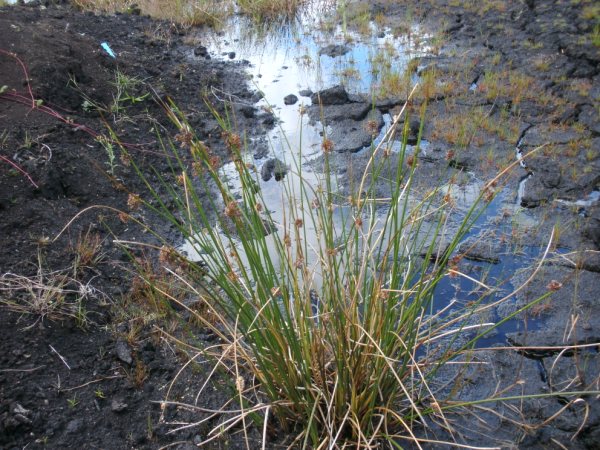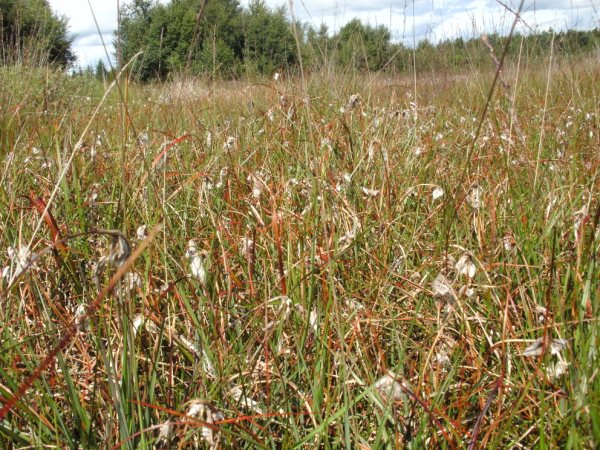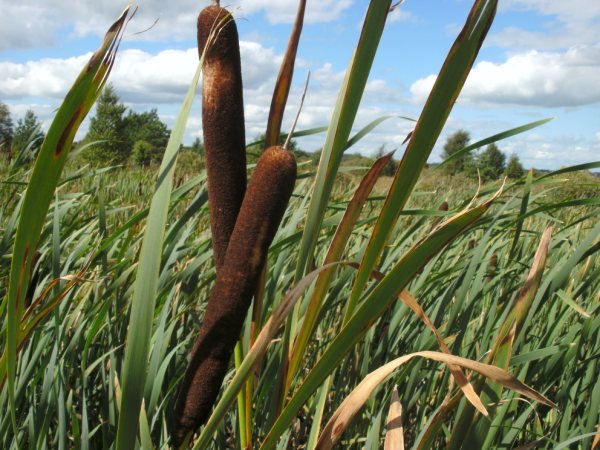.
The cuckoo flower.
“Oh, that one’s bad luck if you take it into the house,” my mother said, so we left it where it showed four pink petals and a greeny yellow heart.
The devil’s bit scabious.
“No,” my mother said, examining the bluish purple blossom. “I don’t know what it’s called either.”
I learned cowslip, white clover, oat-grass, creeping buttercup, meadow barley, meadowsweet and – floating at the tranquil edges of the croaking, churning quagmire – watercress and forget-me-not. When it came to the rarest Callows flower, bell-shaped and creamy white and hidden among the prevailing browns and greens, I would have to wait, as with the devil’s bit scabious, until a book identified the “summer snowflake”.
I hungered for books but books were scarce in our house. Though my mother appreciated the value of books, money was often too short to afford them and the nearest library an inconvenient eight miles away, in Loughrea. I made do for a long time with a huge tome called Flaming Flamingos that my uncle Mattie had brought. All of nature seemed contained in that book. The Camargue, Lake Nakuru, the Orinoco, that book whetted my hunger. It widened my thought even if I often got stuck in the mud of its ornithological intent. Over time it grew shabby and dog-eared and its spine broke. Finally someone must have fecked it into the fire while I wasn’t looking. But still it lingered even as I walked the Callows with my mother and the flamingos lit up those river meadows in my imagination.
The Callows was big when I was small. It flooded or was supposed to flood in spring and autumn. Flooding is too strong a word. It stayed dry on higher areas and even in winter offered more a splashy sheet of wetness than a flood. It held marshy tracts as well but we and the handful of neighbours who shared it always called it Callows and this, together with its four rivers, made it one. I’m certain that the further back I go into my childhood, the slobbier, wetter, more unstable the Callows becomes.
It was entirely treeless apart from a few diminutive blackthorn bushes nibbled by the wind as much as by any grazing animal. Its rivers, too small to carry names, trickled beyond their banks in some places but in others made me gawp at the force of the fresh current that linked them to the main river flowing across Foxhall Little and away outside the reach of my thoughts.
Several harsh-throated, drab-plumed birds depended on the Callows. Greenland geese flying in V shape made weary-sounding, high-pitched cries and the creaking of their wings – together with their feral smell – filled my head. Shyer than my mother’s geese, they wheeled their large white-fronted bodies about and chose to land well away from where I stood. Whooper swans stuck out their black and yellow beaks, hissing a warning as I skirted the turlough. Golden plovers, more white than gold, reeled in flocks, resembling miniature pieces of flickering litter as their bodies caught the sunlight. Wild ducks, the males with their vivid plumage, dipped and dabbled. The corncrake broadcast his arrival in late spring by “serenading” the world night after night, his voice harsher than two rusty nails being scraped together.
Some birds stayed all year. The curlew rose almost straight up and made me feel melancholy by the way he called his own name as he glided back to earth. The sound of the snipe’s drumming tail-feathers always stopped me in my tracks, and his zigzag flight easily deceived my eye. The skylark dwindled to a heavenly dot, singing as he rose.
“Closer, closer,” the quagmire croaked when my mother let me go alone. I would step and thrill and step until my wellingtons got stuck. More than once I had to scramble back or even to step out of them in order to escape. I gave up this game the day one wellington slowly filled with mud and sank without trace.
The Callows became a kind of outback to which I could escape and go walkabout. I never felt less lonely than when alone there. Often I felt sad as a child, the sadness of disappointment. I wondered what the disappointment was. Maybe, I told myself, it involved the waiting that had to happen before I could do the ‘great thing’ for which I had been born and would be remembered. Maybe it included the worry of being responsible for this great achievement, the nature of which I had not the least inkling.
Mostly I tried to coax the sadness to behave itself the way I might Jack, our jet-black pony, a kicker and a biter. Everyone must carry the disappointment that is part of them, I decided. But in the Callows the disappointing mope in my heart would shrink and I’d find exhilaration by sprinting barefoot and fast. A salt taste tanged my mouth and heat rose behind my ears; sometimes a stitch jabbed at my heart. Later, a similar abandon erupted in fights with other boys – the thrill of landing a telling blow, of ending a pent-up frustration. In my teens the drumbeat and the squawking of an electric guitar across the darkness from the dance carnival at Mullagh Cross also tapped into this sensation as powerful and primal and worth bringing on.
The Callows let me live in the moment and the moment could run and run until I completely forgot myself or, for that matter, other people’s opinions of me. I was in my own manner “forgetting human words”, as W. B. Yeats said of Synge. I see now that I didn’t have even the most basic sense of how to care for myself. I went without a coat in rain or frost no matter how often my mother might advise me to wear one. The cold and the wet and the pain served as balm against the sadness I felt. They couldn’t stop me from exulting each time I sprinted and turned and sprinted again.
Years later, when I was a young teacher, I worked with boys who reminded me of myself as a child. They, too, went without. Some, unlike me, lived in utter poverty or wilful neglect. Others suffered a lack of physical affection similar to my own. Cold and hunger were second nature to them. They had far more genuine excuses for being difficult or disruptive than I ever had – but I still recognise the boy I was, the boy who thought himself king of the Callows and who would happily have thrown away the blanket of mist and the cold kiss of a frog for the touch of human warmth that wasn’t given – not out of any meanness on the part of my parents, for they didn’t have a scrap of meanness in them, but because in the way of that time such things just weren’t done.
My need deepened as I grew older. At first I cycled to and from St. Brendan’s College in Loughrea. Cycling meant breezes and drenchings, but I refused to wear an overcoat. Cycling also meant avoidance of talk, especially with girls. And when the bus took the place of the bike, the driver – lamp-headed, incandescently so – said go up the road to Castlenancy or I won’t stop for you. There they were – the girls, their long hair shining and the shape of their breasts and thighs suggested behind the ruck and pucker of convent uniforms. I stole looks at them, racked my brain trying to think of something smart to say. If I could only speak the first sentence… but no, I looked away again, stayed dumb for five years, give or take, and the girls stayed dumb with me.
“Look down,” the wet meadow whispered.
Black oily goo oozed from a wound in one place, while in another a seepage of glorious rusty orange happened. I saw feathers scattered where a fox or hawk had struck, and a crow standing on a dead sheep’s head, trying to lever out its eye. I didn’t wonder about ugliness or beauty, cruelty or compassion, or if I did the Callows wasn’t bothered.
Nor was it bothered when one spring a group of about twenty men arrived with nets – an extensive network of nets – and used thin rods to set them in place in the shape of a huge, open-mouthed pen. The men spread out along the perimeter of the Callows and beat the vegetation, shooing and hallooing. Hares rose and ran ahead of them until eventually there was a drove of maybe a hundred hares. These were flocked into the pen, where they frantically scrabbled against the netting even as it closed on them. They would be used at coursing events in various country towns where most, if not all of them, would be torn asunder by competing hounds.
I felt powerless. The big world couldn’t be kept away. Its entertainments were the same as its hungers: they required to be fed. A small dread started in me there. The future would happen, changing everything, including myself. I understood at some basic level that I would have to leave when the future came. My only solution was to immerse myself ever more deeply in the Callows.
At each visit I would lift the large flat stone that lay at the Callows’ edge. There I might find a slug the colour of a lemon drop, a centipede that resembled a frazzled piece of twine, or a harvestman taking slow, articulated steps as if he were a flimsy wound-up toy. They couldn’t stand the light of day and maybe that’s why I loved them – they were shyer even than me.
Then I would enter the cold, queasy pottage of what I would later describe in a poem as “land aspiring to be water; water wanting to be land”. It had the raw look of a place still beginning. It didn’t hold out much hope of anything remarkable. But if you leaned into it, if you stayed quiet enough for long enough, its creatures would forget you and make free. So I heard the pheasant hiccoughing as though drunk with sunset, and I found the eels – collectively if implausibly known as “a fry” – slithering their way across the waterland.
One evening I dug below the dank mat of roots and soil and clutched up a fistful of white dripping clay. It was marl, but I didn’t know that then. Slowly I crumpled its gritty sponge and found isolated on my palm three small egg-shaped shells. Smooth and whorled and beautiful to my eye but, after holding onto them for a day or two, I gave them to my mother. She could hardly have looked happier if I had given her a pearl necklace.
“Maybe the Callows was a lake,” she suggested. “Maybe water snails lived there long ago.”
“But when was that?”
“Oh, not since Adam was a boy.”
She let the shells drop into the torn pocket of her apron where she assured me they would be safe, and I have no recollection of her ever mentioning them beyond that.
The Callows stayed with me long after I’d grown up and “become sensible”. Its landscape turned into thought. I wanted to preserve its sights and sounds and smells the way I tried to restrain three pheasants in a furze clump once, “flocking” them with my hands for several minutes until finally they burst upwards past my chest and face to escape. Nearly four decades later I recalled
the marl excavations: white, with small
tell-tale shells remembering a lake
where the Callows found its first
foothold – and where your heart’s pangs
are shallow waves, breaking still.
My mother had become old and enfeebled now, laid up in Portiuncula Hospital after yet another stroke, one more sweeping of the ground from under her. I had drawn the bed curtain across, sat with her through the night. I stayed awake listening to her breath, her scraping restlessness, and staring at the Callows meadow scene painted on the curtain itself. Flowers aplenty there, patches of water, tall grasses.
Towards dawn I held her wrist while the doctor clumsily took blood. Some blood squirted from his syringe onto the curtain where it formed a black flower among the lightening colours of the wetland meadow – one more beauty to add to the forty plus species per square metre that river meadows are capable of supporting. I thought of the many walks she and I had taken together. And I found myself wishing for the shells back, or maybe for the moment of offering them to her again.
—Patrick Deeley
.
 Patrick Deeley via Five Glens Arts Festival
Patrick Deeley via Five Glens Arts Festival
Patrick Deeley was born in Loughrea, Co. Galway in 1953, and currently lives in Dublin. His poetry collections published by Dedalus Press include Intimate Strangers (1986), Names For Love (1990), Turane: the Hidden Village (1995), Decoding Samara (2001), The Bones of Creation (2008) and Groundswell: New and Selected Poems (2013). He is the recipient of a number of bursaries and poetry prizes, and translations of his work to French and Italian have come from Alidades Press and Kolibris Edizione respectively. “A Callows Childhood” is an extract from a memoir, The Hurley-Maker’s Son. His personal website is here.
.
.





If this extract is anything to go by we are in for a literary treat when Deeley’s Memoir is published….by turns evocative, clear eyed, tender and fiercely honest: this is a work of Art as deeply felt and keenly honed as his poetry.
What a wonderful memoir –like all fine memois, it keeps one foot in the immediate and particular, and another in the cosmos. A delight to read.